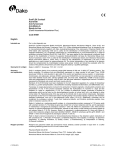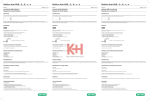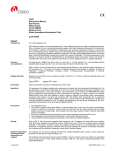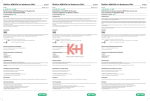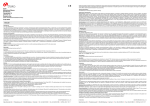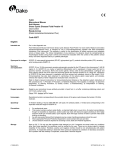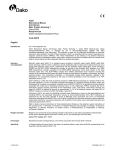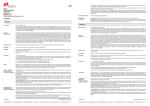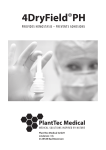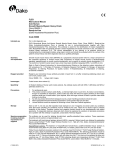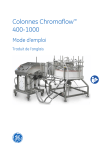Download FLEX Monoclonal Mouse Anti-Human Melan-A Clone A103
Transcript
Counterstaining in hematoxylin is recommended using EnVision FLEX Hematoxylin (Dako Autostainer/Autostainer Plus) (Code K8018). Non-aqueous, permanent mounting medium is recommended. Positive and negative controls should be run simultaneously using the same protocol as the patient specimens. The positive control tissue should include normal skin and malignant melanoma and the cells/structures should display reaction patterns as described for this tissue in “Performance characteristics” in all positive specimens. The recommended negative control reagent is FLEX Negative Control, Mouse (Dako Autostainer/Autostainer Plus) (Code IS750). FLEX Monoclonal Mouse Anti-Human Melan-A Clone A103 Ready-to-Use (Dako Autostainer/Autostainer Plus) Staining interpretation The cellular staining pattern is cytoplasmic. Code IS633 ENGLISH Intended use For in vitro diagnostic use. FLEX Monoclonal Mouse Anti-Human Melan-A, Clone A103, Ready-to-Use, (Dako Autostainer/ Autostainer Plus), is intended for use in immunohistochemistry together with Dako Autostainer/Autostainer Plus instruments. This antibody is useful for the identification of melanomas (1, 2), and, if melanoma is ruled out, for adrenocortical carcinomas (3, 4). The antibody is also applicable as a useful marker for angiomyolipomas (5). The clinical interpretation of any staining or its absence should be complemented by morphological studies using proper controls and should be evaluated within the context of the patient's clinical history and other diagnostic tests by a qualified pathologist. Synonym for antigen MART-1 Summary and explanation Melan-A, isolated as a melanoma-specific antigen, is a transmembrane protein composed of 118 amino acids with uncertain function (1). The Melan-A gene was cloned from a human melanoma cell line, and its expression on melanomas is recognized by autologous cytotoxic T cells (6). Melan-A is expressed in skin, retina and the majority of cultured melanocytes and melanomas, whereas a vast variety of other tissues and cancers tested do not express Melan-A (1, 6, 7). However, Melan-A is expressed in angiomyolipomas (5). Along with Melan-A, seven other melanoma antigens have been identified: MAGE-1, MAGE-3, tyrosinase, gp100, gp75, BAGE-1 and GAGE-1, which are all recognized by autologous cytotoxic T cells (1). Refer to Dako’s General Instructions for Immunohistochemical Staining or the detection system instructions of IHC procedures for: 1) Principle of Procedure, 2) Materials Required, Not Supplied, 3) Storage, 4) Specimen Preparation, 5) Staining Procedure, 6) Quality Control, 7) Troubleshooting, 8) Interpretation of Staining, 9) General Limitations. Reagent provided Ready-to-use monoclonal mouse antibody provided in liquid form in a buffer containing stabilizing protein and 0.015 mol/L NaN3. Clone: A103. Isotype: IgG1, kappa. Immunogen Recombinant protein expressed in E. coli corresponding to Melan-A (1). Specificity In Western blotting of cell lysates from Melan-A mRNA positive cell lines, the antibody labels a protein doublet of 20-22 kDa, whereas no labelling is detected in Melan-A mRNA-negative cell lines (1). In immunoprecipitates of Melan-A positive cell lines SK-MEL-13 and SK-MEL-19, the antibody labels a protein doublet of 20-22 kDa corresponding to Melan-A, whereas no precipitation is detected in Melan-A mRNA-negative melanoma cell lines (1). Precautions 1. For professional users. 2. This product contains sodium azide (NaN3), a chemical highly toxic in pure form. At product concentrations, though not classified as hazardous, sodium azide may react with lead and copper plumbing to form highly explosive build-ups of metal azides. Upon disposal, flush with large volumes of water to prevent metal azide build-up in plumbing. 3. As with any product derived from biological sources, proper handling procedures should be used. 4. Wear appropriate Personal Protective Equipment to avoid contact with eyes and skin. 5. Unused solution should be disposed of according to local, State and Federal regulations. Storage Store at 2-8 °C. Do not use after expiration date s tamped on vial. If reagents are stored under any conditions other than those specified, the conditions must be verified by the user. There are no obvious signs to indicate instability of this product. Therefore, positive and negative controls should be run simultaneously with patient specimens. If unexpected staining is observed which cannot be explained by variations in laboratory procedures and a problem with the antibody is suspected, contact Dako Technical Support. Specimen preparation including materials required but not supplied The antibody can be used for labeling formalin-fixed, paraffin-embedded tissue sections. Tissue specimens should be cut into sections of approximately 4 µm. Pre-treatment with heat-induced epitope retrieval (HIER) is required using Dako PT Link (Code PT100/PT101). For details, please refer to the PT Link User Guide. Optimal results are obtained by pretreating tissues using EnVision FLEX Target Retrieval Solution, High pH (50x) (Code K8010/K8004). Paraffin-embedded sections: Pre-treatment of formalin-fixed, paraffin-embedded tissue sections is recommended using the 3-in-1 specimen preparation procedure for Dako PT Link. Follow the pre-treatment procedure outlined in the package insert for EnVision FLEX Target Retrieval Solution, High pH (50x) (Code K8010/K8004). Note: After staining the sections must be dehydrated, cleared and mounted using permanent mounting medium. Deparaffinized sections: Pre-treatment of deparaffinized formalin-fixed, paraffin-embedded tissue sections is recommended using Dako PT Link and following the same procedure as described for paraffin-embedded sections. After staining the slides should be mounted using aqueous or permanent mounting medium. The tissue sections should not dry out during the treatment or during the following immunohistochemical staining procedure. For greater adherence of tissue sections to glass slides, the use of FLEX IHC Microscope Slides (Code K8020) is recommended. Staining procedure including materials required but not supplied The recommended visualization system is EnVision FLEX, High pH (Dako Autostainer/Autostainer Plus) (Code K8010). The staining steps and incubation times are preprogrammed into the software of Dako Autostainer/Autostainer Plus instruments, using the following protocols: Template protocol: FLEXRTU2 (200 µL dispense volume) or FLEXRTU3 (300 µL dispense volume) Autoprogram: MelanA (without counterstaining) or MelanAH (with counterstaining) The Auxiliary step should be set to “rinse buffer” in staining runs with ≤10 slides. For staining runs with >10 slides the Auxiliary step should be set to “none”. This ascertains comparable wash times. All incubation steps should be performed at room temperature. For details, please refer to the Operator’s Manual for the dedicated instrument. If the protocols are not available on the used Dako Autostainer platform, please contact Dako Technical Services. Optimal conditions may vary depending on specimen and preparation methods, and should be determined by each individual laboratory. If the evaluating pathologist should desire a different staining intensity, a Dako Application Specialist/Technical Service Specialist can be contacted for information on re-programming of the protocol. Verify that the performance of the adjusted protocol is still valid by evaluating that the staining pattern is identical to the staining pattern described in “Performance characteristics”. (115277-002) Dako Denmark A/S IS633/MNI/2009.12.04 p. 1/4 | Produktionsvej 42 | DK-2600 Glostrup | Denmark | Tel. +45 44 85 95 00 | Fax +45 44 85 95 95 | CVR No. 33 21 13 17 Performance characteristics Normal tissues: The antibody labels skin, whereas stomach, colon, lung, liver, spleen, kidney, testis, urinary bladder, breast, ovary, smooth muscle and adipose tissues are not labelled by the antibody (1, 5). The steroid-producing cells of adrenal cortex, ovary and testis have been reported to be labeled by the antibody (2). Abnormal tissues: In metastatic melanomas 16/21 cases were labeled by the antibody, showing positive homogeneous, cytoplasmic staining in >80-90% of melanoma cells, except one which displayed focal staining (1). In another study of 10 benign melanocytic nevi, 10 primary melanomas and 75 metastatic melanomas, the antibody labelled 10/10 benign melanocytic nevi, 7/10 primary melanomas and 61/75 metastatic melanomas (2). Among 111 carcinomas, mainly adenocarcinomas and squamous cell carcinomas, 40 germ cell tumors and 33 miscellaneous non-melanocytic epithelioid tumors, none were labelled by the antibody. The antibody labeled 5/5 adrenal cortical adenomas, 16/16 primary and 13/13 metastatic adrenal cortical carcinomas, and also 4/4 Leydig cell tumors of the testis and 3/4 Sertoli-Leydig cell tumors of the ovary were labeled by the antibody (3). In another study of 316 cases, including 21 adrenal cortical tumors, 16 metastatic carcinomas to the adrenal, 10 pheochromocytomas, and 269 extra-adrenal carcinomas, the antibody labeled 14/14 adrenal cortical adenomas, 7/7 adrenal cortical carcinomas, 0/16 metastatic carcinomas to the adrenal and 0/10 pheochromocytomas. Of the 269 extra-adrenal carcinomas, a single ovarian serous carcinoma was labeled (4). In a study of 18 angiomyolipomas, all 18 were labeled by the antibody (5). In another report all three angiomyolipomas tested were labeled by the antibody (2). FRANÇAIS Utilisation prévue Pour utilisation diagnostique in vitro. FLEX Monoclonal Mouse Anti-Human Melan-A, Clone A103, Ready-to-Use, (Dako Autostainer/ Autostainer Plus) est destiné à une utilisation en immunohistochimie avec les instruments Dako Autostainer/ Autostainer Plus. Cet anticorps est utile pour l’identification des mélanomes (1, 2) et, si le mélanome est exclu, des carcinomes corticosurrénaux (3, 4). L’anticorps est également applicable comme marqueur pour les angiomyolipomes (5). L’interprétation clinique de toute coloration ou son absence doit être complétée par des études morphologiques en utilisant des contrôles appropriés et doit être évaluée en fonction des antécédents cliniques du patient et d’autres tests diagnostiques par un pathologiste qualifié. Synonyme de l’antigène MART-1 Résumé et explication Le Melan-A, isolé en tant qu’antigène spécifique des mélanomes, est une protéine transmembranaire constituée de 118 acides aminés dont la fonction est incertaine (1). Le gène Melan-A a été cloné à partir d’une lignée cellulaire de mélanome humain, et son expression sur les mélanomes est reconnue par les lymphocytes T cytotoxiques autologues (6). Le Melan-A est exprimé dans la peau, la rétine et la majorité des mélanocytes et mélanomes mis en culture, tandis qu’une grande variété d'autres tissus et de cancers testés n’expriment pas le Melan-A (1, 6, 7). Cependant, le Melan-A est exprimé dans les angiomyolipomes (5). Outre le Melan-A, sept autres antigènes des mélanomes ont été identifiés : MAGE-1, MAGE-3, tyrosinase, gp100, gp75, BAGE-1 et GAGE-1, qui sont tous reconnus par les lymphocytes T cytotoxiques autologues (1). Se référer aux Instructions générales de coloration immunohistochimique de Dako ou aux instructions du système de détection relatives aux procédures IHC pour plus d’informations concernant les points suivants : 1) Principe de procédure, 2) Matériels requis mais non fournis, 3) Conservation, 4) Préparation des échantillons, 5) Procédure de coloration, 6) Contrôle qualité, 7) Dépannage, 8) Interprétation de la coloration, 9) Limites générales. Réactifs fournis Anticorps monoclonal de souris prêt à l’emploi fourni sous forme liquide dans un tampon contenant une protéine stabilisante et 0,015 mol/L d’azide de sodium. Clone : A103. Isotype : IgG1, kappa. Immunogène Protéine recombinante exprimée dans E. coli correspondant au Melan-A (1). Spécificité Lors d’analyse par Western blot de lysats cellulaires provenant de lignées cellulaires positives à l’ARNm du Melan-A, l’anticorps marque un doublet protéique de 20-22 kDa, alors qu’aucun marquage n’est détecté dans les lignées cellulaires négatives à l’ARNm du Melan-A (1). Dans les immunoprécipités de lignées cellulaires SK-MEL-13 et SK-MEL-19 positives au Melan-A, l’anticorps marque un doublet protéique de 20–22 kDa correspondant au Melan-A, alors qu’aucune précipitation n’est détectée dans les lignées cellulaires négatives à l’ARNm du Melan-A (1). Précautions 1. Pour utilisateurs professionnels. 2. Ce produit contient de l’azide de sodium (NaN3), produit chimique hautement toxique dans sa forme pure. Aux concentrations du produit, bien que non classé comme dangereux, l’azide de sodium peut réagir avec le cuivre et le plomb des canalisations et former des accumulations d’azides métalliques hautement explosifs. Lors de l’élimination, rincer abondamment à l’eau pour éviter toute accumulation d’azide métallique dans les canalisations. 3. Comme avec tout produit d’origine biologique, des procédures de manipulation appropriées doivent être respectées. 4. Porter un vêtement de protection approprié pour éviter le contact avec les yeux et la peau. 5. Les solutions non utilisées doivent être éliminées conformément aux réglementations locales et nationales. Conservation Conserver entre 2 et 8 °C. Ne pas utiliser après la date de péremption indiquée sur le flacon. Si les réactifs sont conservés dans des conditions autres que celles indiquées, celles-ci doivent être validées par l’utilisateur. Il n’y a aucun signe évident indiquant l’instabilité de ce produit. Par conséquent, des contrôles positifs et négatifs doivent être testés en même temps que les échantillons de patient. Si une coloration inattendue est observée, qui ne peut être expliquée par un changement des procédures du laboratoire, et en cas de suspicion d’un problème lié à l’anticorps, contacter l’assistance technique de Dako. Préparation des échantillons y compris le matériel requis mais non fourni L’anticorps peut être utilisé pour le marquage des coupes de tissus inclus en paraffine et fixés au formol. L’épaisseur des coupes d’échantillons de tissu doit être d’environ 4 µm. Un prétraitement avec démasquage d’épitope induit par la chaleur (HIER) est nécessaire avec le Dako PT Link (Réf. PT100/PT101). Pour plus de détails, se référer au Guide d’utilisation du PT Link. Des résultats optimaux sont obtenus en prétraitant les tissus à l’aide de la EnVision FLEX Target Retrieval Solution, High pH (50x) (Réf. K8010/K8004). Coupes incluses en paraffine : le prétraitement des coupes tissulaires fixées au formol et incluses en paraffine est recommandé à l'aide de la procédure de préparation d'échantillon 3-en-un pour le Dako PT Link. Suivre la procédure de prétraitement indiquée dans la notice de la EnVision FLEX Target Retrieval Solution, High pH (50x) (Réf. K8010/K8004). Remarque : après coloration, les coupes doivent être déshydratées, lavées et montées à l’aide d’un milieu de montage permanent. Coupes déparaffinées : le prétraitement des coupes tissulaires déparaffinées, fixées au formol et incluses en paraffine, est recommandé à l’aide du Dako PT Link, en suivant la même procédure que pour les coupes incluses en paraffine. Après coloration, un montage aqueux ou permanent des lames est recommandé. Les coupes de tissus ne doivent pas sécher lors du traitement ni lors de la procédure de coloration immunohistochimique suivante. Pour une meilleure adhérence des coupes de tissus sur les lames de verre, il est recommandé d’utiliser des lames FLEX IHC Microscope Slides (Réf. K8020). (115277-002) Dako Denmark A/S IS633/MNI/2009.12.04 p. 2/4 | Produktionsvej 42 | DK-2600 Glostrup | Denmark | Tel. +45 44 85 95 00 | Fax +45 44 85 95 95 | CVR No. 33 21 13 17 Procédure de coloration y compris le matériel requis mais non fourni Le système de visualisation recommandé est le EnVision FLEX, High pH, (Dako Autostainer/Autostainer Plus) (Réf. K8010). Les étapes de coloration et d’incubation sont préprogrammées dans le logiciel des instruments Dako Autostainer/Autostainer Plus, à l’aide des protocoles suivants : Protocole modèle : FLEXRTU2 (volume de distribution de 200 µL) ou FLEXRTU3 (volume de distribution de 300 µL) Autoprogram : MelanA (sans contre-coloration) ou MelanAH (avec contre-coloration) L’étape Auxiliary doit être réglée sur « rinse buffer » lors des cycles de coloration avec ≤10 lames. Pour les cycles de coloration de >10 lames, l’étape Auxiliary doit être réglée sur « none ». Cela garantit des temps de lavage comparables. Toutes les étapes d’incubation doivent être effectuées à température ambiante. Pour plus de détails, se référer au Manuel de l’opérateur spécifique à l'instrument. Si les protocoles ne sont pas disponibles sur la plateforme Dako Autostainer utilisée, contacter le service technique de Dako. Les conditions optimales peuvent varier en fonction du prélèvement et des méthodes de préparation, et doivent être déterminées par chaque laboratoire individuellement. Si le pathologiste qui réalise l’évaluation désire une intensité de coloration différente, un spécialiste d’application/spécialiste du service technique de Dako peut être contacté pour obtenir des informations sur la re-programmation du protocole. Vérifier que l'exécution du protocole modifié est toujours valide en vérifiant que le schéma de coloration est identique au schéma de coloration décrit dans les « Caractéristiques de performance ». Il est recommandé d’effectuer une contre-coloration à l’aide de EnVision( FLEX Hematoxylin (Dako Autostainer/Autostainer Plus) (Réf. K8018). L’utilisation d’un milieu de montage permanent non aqueux est recommandée. Des contrôles positifs et négatifs doivent être réalisés en même temps et avec le même protocole que les échantillons du patient. Le contrôle de tissu positif doit comprendre la peau saine et le mélanome malin et les cellules/structures doivent présenter des schémas de réaction tels que décrits pour ces tissus dans les « Caractéristiques de performance » pour tous les échantillons positifs. Le contrôle négatif recommandé est le FLEX Negative Control, Mouse, (Dako Autostainer/Autostainer Plus) (Réf. IS750). Interprétation de la coloration Le schéma de coloration cellulaire est cytoplasmique. Caractéristiques de performance Tissus sains : L’anticorps marque la peau, alors que l’estomac, le côlon, le poumon, le foie, la rate, le rein, le testicule, la vessie, le sein, l’ovaire, les cellules du muscle lisse et les tissus adipeux ne sont pas marqués par l’anticorps (1, 5). Il a été signalé que les cellules productrices de stéroïdes du cortex surrénal, de l’ovaire et du testicule étaient marquées par l’anticorps (2). Tissus tumoraux : Pour les mélanomes métastatiques, 16 cas sur 21 ont été marqués par l’anticorps, avec un marquage cytoplasmique positif homogène dans 80 à 90 % des cellules de mélanomes, à l’exception d’un cas qui a présenté une coloration focale (1). Lors d’une autre étude, l’anticorps a marqué 10 nævi mélanocytaires bénins sur 10, 7 mélanomes primaires sur 10 et 61 mélanomes métastatiques sur 75 (2). Sur 111 carcinomes, principalement des adénocarcinomes et des carcinomes à cellules squameuses, 40 tumeurs à cellules germinales et 33 tumeurs épithélioïdes non mélanocytaires diverses, aucun marquage par l’anticorps n’a été observé. L’anticorps a marqué 5 adénomes corticosurrénaux sur 5, 16 carcinomes corticosurrénaux primaires sur 16 et 13 carcinomes corticosurrénaux métastatiques sur 13, ainsi que 4 tumeurs des cellules de Leydig du testicule sur 4 et 3 tumeurs des cellules de Sertoli- Leydig de l’ovaire sur 4 (3). Lors d’une autre étude portant sur 316 cas, dont 21 tumeurs corticosurrénales, 16 carcinomes métastatiques de la surrénale, 10 phéochromocytomes et 269 carcinomes extra-surrénaux, l’anticorps a marqué 14 adénomes corticosurrénaux sur 14, 7 carcinomes corticosurrénaux sur 7, 0 carcinome métastatique de la surrénale sur 16 et 0 phéochromocytome sur 10. Parmi les 269 carcinomes extra-surrénaux, un seul carcinome séreux de l’ovaire a été marqué (4). Lors d’une étude, 18 angiomyolipomes sur 18 ont été marqués par l’anticorps (5). Dans un autre rapport, les trois angiomyolipomes testés ont été marqués par l’anticorps (2). DEUTSCH Zweckbestimmung Zur In-vitro-Diagnostik. FLEX Monoclonal Mouse Anti-Human Melan-A, Clone A103, Ready-to-Use, (Dako Autostainer/Autostainer Plus) ist zur Verwendung in der Immunhistochemie in Verbindung mit Dako Autostainer/Autostainer Plus-Geräten bestimmt. Dieser Antikörper dient zur Erkennung von Melanomen (1, 2) und (falls Melanome ausgeschlossen werden können) Karzinomen der Nebennierenrinde (3, 4). Der Antikörper kann auch als nützlicher Marker für Angiomyolipome dienen (5). Die klinische Auswertung einer eventuell eintretenden Färbung sollte durch morphologische Studien mit ordnungsgemäßen Kontrollen ergänzt werden und von einem qualifizierten Pathologen unter Berücksichtigung der Krankengeschichte und anderer Diagnostiktests des Patienten vorgenommen werden. Synonym für das Antigen MART-1 Zusammenfassung und Erklärung Melan-A, isoliert als ein melanomspezifisches Antigen, ist ein Transmembranprotein mit ungeklärter Funktion, das aus 118 Aminosäuren besteht (1). Das Melan-A-Gen wurde aus einer menschlichen Melanomzelllinie geklont, und seine Expression auf Melanomen wird von autologen zytotoxischen T-Zellen erkannt (6). Melan-A wird auf Zellen der Haut, der Netzhaut und dem Großteil der Melanozyten und Melanome aus Kultur exprimiert, während der weit überwiegende Teil anderer untersuchter Gewebe und Karzinome Melan-A nicht exprimiert (1, 6, 7). Melan-A wird jedoch in Angiomyolipomen exprimiert (5). Neben Melan-A wurden noch sieben weitere Melanomantigene identifiziert: MAGE1, MAGE-3, Tyrosinase, gp100, gp75, BAGE-1 und GAGE-1. Diese werden alle von autologen zytotoxischen T-Zellen erkannt (1). Folgende Angaben bitte den Allgemeinen Richtlinien zur immunhistochemischen Färbung von Dako oder den Anweisungen des Detektionssystems für IHC-Verfahren entnehmen: 1) Verfahrensprinzip, 2) Erforderliche, aber nicht mitgelieferte Materialien, 3) Aufbewahrung, 4) Vorbereitung der Probe, 5) Färbeverfahren, 6) Qualitätskontrolle, 7) Fehlersuche und -behebung, 8) Auswertung der Färbung, 9) Allgemeine Beschränkungen. Geliefertes Reagenz Gebrauchsfertiger, monoklonaler Maus-Antikörper in flüssiger Form in einem Puffer, der stabilisierendes Protein und 0,015 mol/L NaN3 enthält. Klon: A103. Isotyp: IgG1, Kappa. Immunogen Rekombinantes Protein, in E. coli exprimiert und Melan-A entsprechend (1). Spezifität Beim Western-Blotting von Zelllysaten aus Melan-A-mRNA-positiven Zelllinien markiert der Antikörper ein Proteinpaar von 20–22 kDa, während in Melan-A-mRNA-negativen Zellinien keine Markierung nachgewiesen werden konnte (1). In den Immunpräzipitaten der Melan-A-positiven Zelllinien SK-MEL-13 und SK-MEL-19 markiert der Antikörper ein Melan-A entsprechendes Proteinpaar mit einem Gewicht von 20–22 kDa, während in Melanom-Zelllinien, welche Melan-A-mRNA-negativ sind, keine Präzipitation nachgewiesen wird (1). Vorbereitung der Probe und erforderliche, aber nicht mitgelieferte Materialien Der Antikörper eignet sich zur Markierung von formalinfixierten und paraffineingebetteten Gewebeschnitten. Gewebeproben sollten in Schnitte von ca. 4 µm Stärke geschnitten werden. Die Vorbehandlung durch hitzeinduzierte Epitopdemaskierung (HIER) mit Dako PT Link (Code-Nr. PT100/PT101) ist erforderlich. Weitere Informationen hierzu siehe PT LinkBenutzerhandbuch. Optimale Ergebnisse können durch Vorbehandlung der Gewebe mit EnVision FLEX Target Retrieval Solution, High pH (50x) (Code-Nr. K8010/K8004) erzielt werden. Paraffineingebettete Schnitte: Die Vorbehandlung der formalinfixierten, paraffineingebetteten Schnitte mit dem 3-in-1-Probenvorbereitungsverfahren für Dako PT Link wird empfohlen. Vorbehandlung gemäß der Beschreibung in der Packungsbeilage für EnVision FLEX Target Retrieval Solution, High pH (50x) (Code-Nr. K8010/K8004) durchführen. Hinweis: Nach dem Färben müssen die Schnitte dehydriert, geklärt und mit permanentem Einbettmedium auf den Objektträger aufgebracht werden. Entparaffinierte Schnitte: Eine Vorbehandlung der entparaffinierten, formalinfixierten, paraffineingebetteten Gewebeschnitte mit Dako PT Link nach demselben Verfahren, wie für die paraffineingebetteten Schnitte beschrieben, wird empfohlen. Die Objektträger nach dem Färben mit einem wässrigen oder permanenten Einbettmedium bedecken. Die Gewebeschnitte dürfen während der Behandlung oder des anschließenden immunhistochemischen Färbeverfahrens nicht austrocknen. Zur besseren Haftung der Gewebeschnitte an den Glasobjektträgern wird die Verwendung von FLEX IHC Microscope Slides (Code-Nr. K8020) empfohlen. Färbeverfahren und erforderliche, aber nicht mitgelieferte Materialien Das empfohlene Visualisierungssystem ist EnVision™ FLEX, High pH (Dako Autostainer/Autostainer Plus) (Code-Nr. K8010). Die Färbeschritte und Inkubationszeiten sind in der Software der Dako Autostainer/Autostainer Plus-Geräte mit den folgenden Protokollen vorprogrammiert: Matrix-Protokoll: FLEXRTU2 (200 µL Abgabevolumen) oder FLEXRTU3 (300 µL Abgabevolumen) Autoprogram: MelanA (ohne Gegenfärbung) oder MelanAH (mit Gegenfärbung) Bei Färbedurchläufen mit höchstens 10 Objektträgern sollte der „Zusatz“-Schritt auf „Pufferspülgang“ eingestellt werden. Für Färbedurchläufe mit mehr als 10 Objektträgern den „Zusatz“-Schritt auf „Keine“ einstellen. Dieses gewährleistet vergleichbare Waschzeiten. Alle Inkubationsschritte sollten bei Raumtemperatur durchgeführt werden. Nähere Einzelheiten bitte dem Benutzerhandbuch für das jeweilige Gerät entnehmen. Wenn die Färbeprotokolle auf dem verwendeten Dako Autostainer-Gerät nicht verfügbar sind, bitte den Technischen Kundendienst von Dako verständigen. Optimale Bedingungen können je nach Probe und Präparationsverfahren unterschiedlich sein und sollten vom jeweiligen Labor selbst ermittelt werden. Falls der beurteilende Pathologe eine andere Färbungsintensität wünscht, kann ein Anwendungsspezialist oder Kundendiensttechniker von Dako bei der Neuprogrammierung des Protokolls helfen. Die Leistung des angepassten Protokolls muss verifiziert werden, indem gewährleistet wird, dass das Färbemuster mit dem unter „Leistungsmerkmale“ beschriebenen Färbemuster identisch ist. Die Gegenfärbung in Hämatoxylin sollte mit EnVision™ FLEX Hematoxylin, (Dako Autostainer/Autostainer Plus) (Code-Nr. K8018) ausgeführt werden. Empfohlen wird ein nichtwässriges, permanentes Fixiermittel. Positiv- und Negativkontrollen sollten zur gleichen Zeit und mit demselben Protokoll wie die Patientenproben getestet werden. Das positive Kontrollgewebe sollte gesundes Hautgewebe und maligne Melanomzellen enthalten und die Zellen/Strukturen müssen in allen positiven Proben die für dieses Gewebe unter „Leistungsmerkmale“ beschriebenen Reaktionsmuster aufweisen. Das empfohlene Negativ-Kontrollreagenz ist FLEX Negative Control, Mouse (Dako Autostainer/Autostainer Plus) (Code-Nr. IS750). Auswertung der Färbung Das zelluläre Färbemuster ist zytoplasmatisch. Leistungsmerkmale Gesundes Gewebe: Der Antikörper markiert Hautproben, dagegen werden Proben von Magen, Dickdarm, Lunge, Leber, Milz, Niere, Hoden, Harnblase, Brust, Eierstöcken, glatter Muskulatur und Fettgeweben nicht markiert (1, 5). Die steroidproduzierenden Zellen von Nebennierenrinde, Eierstöcken und Hoden wurden Berichten zufolge durch den Antikörper markiert (2). Pathologisches Gewebe: Bei metastatischen Melanomen wurden 16 von 21 Fällen durch den Antikörper markiert und zeigten eine positive homogene zytoplasmatische Färbung in über 80–90 % der Zellen. Nur in einem Fall kam es zu einer örtlich begrenzten Färbung (1). In einer weiteren Studie mit 10 benignen Melanozyten-Naevi, 10 primären und 75 metastatischen Melanomen markierte der Antikörper 10 von 10 Fällen der benignen Melanozyten-Naevi, 7 von 10 der primären und 61 von 75 der metastatischen Melanome (2). Von 111 Karzinomen, hauptsächlich Adenokarzinomen und Plattenepithelkarzinomen, 40 Keimzelltumoren und 33 diversen epitheloiden Nicht-Melanozyten-Tumoren, wurde kein einziger Fall durch den Antikörper markiert. Der Antikörper markierte 5 von 5 Adenomen der Nebennierenrinde, 16 von 16 primären und 13 von 13 metastatischen Nebennierenrindenkarzinomen sowie 4 von 4 Leydig-Zelltumoren der Hoden und 3 von 4 Sertoli-Leydig-Zelltumoren der Eierstöcke (3). In einer weiteren Studie mit 316 untersuchten Fällen, darunter 21 Nebennierenrindentumore, 16 in die Nebenniere metastasierende Karzinome, 10 Phäochromozytome und 269 extraadrenale Karzinome, markierte der Antikörper 14 von 14 Adenomen der Nebennierenrinde, 7 von 7 Karzinomen der Nebennierenrinde, 0 von 16 metastatischen Karzinomen der Nebenniere und 0 von 10 Phäochromozytomen. Von den übrigen 269 extraadrenalen Karzinomen wurde nur ein einziger Fall eines serösen Eierstock-Karzinoms markiert (4). In einer Studie mit 18 Angiomyolipomen wurden alle 18 Fälle durch den Antikörper markiert (5). Ein weiterer Bericht schildert 3 untersuchte Angiomyolipome, welche ausnahmslos durch den Antikörper markiert wurden (2). References/ Références/ Literatur 1. Chen Y-T, Stockert E, Jungbluth A, Tsang S, Coplan KA, Scanlan MJ, et al. Serological analysis of Melan-A (MART-1), a melanocyte-specific protein homogeneously expressed in human melanomas. Proc Natl Acad Sci 1996;93:5915-9. 2. Jungbluth AA, Busam KJ, Gerald WL, Stockert E, Coplan KA, Iversen K, et al. An anti-Melan-A monoclonal antibody for the detection of malignant melanoma in paraffinembedded tissues. Am J Surg Pathol 1998;22:595-602. 3. Busam KJ, Iversen K, Coplan KA, Old LJ, Stockert E, Chen Y-T, et al. Immunoreactivity for A103, an antibody to Melan-A (Mart-1), in adrenocortical and other steroid tumors. Am J Surg Pathol 1998;22:57-63. 4. Loy TS, Phillips RW, Linder CL. A103 immunostaining in the diagnosis of adrenal cortical tumors. Arch Pathol Lab Med 2002;126:170-2. 5. Jungbluth AA, Iversen K, Coplan K, Williamson B, Chen Y-T, Stockert T, et al. Expression of melanocyte-associated markers gp-100 and Melan-A/MART-1 in angiomyolipomas. Virchows Arch 1999;434:429-35. 6. Coulie PG, Brichard V, Van Pel A, Wölfel T, Schneider J, Traversari C, et al. A new gene coding for a differentiation antigen recognized by autologous cytolytic T lymphocytes on HLA-A2 melanomas. J Exp Med 1994;180:35-42. 7. Kawakami Y, Eliyahu S, Delgado CH, Robbins PF, Rivoltini L, Topalian SL, et al. Cloning of the gene coding for a shared human melanoma antigen recognized by autologous T cells infiltrating into tumor. Proc Natl Acad Sci 1994;91:3515-9. Explanation of symbols/ Explication des symboles/ Erläuterung der Symbole Vorsichtsmaßnahmen 1. Nur für Fachpersonal bestimmt. 2. Dieses Produkt enthält Natriumazid (NaN3), eine in reiner Form äußerst giftige Chemikalie. Natriumazid kann auch in als ungefährlich eingestuften Konzentrationen mit Bleiund Kupferrohren reagieren und hochexplosive Metallazide bilden. Nach der Entsorgung stets mit viel Wasser nachspülen, um Metallazidansammlungen in den Leitungen vorzubeugen. 3. Wie alle Produkte biologischen Ursprungs müssen auch diese entsprechend gehandhabt werden. 4. Geeignete Schutzkleidung tragen, um Augen- und Hautkontakt zu vermeiden. 5. Nicht verwendete Lösung ist entsprechend örtlichen, bundesstaatlichen und staatlichen Richtlinien zu entsorgen. Lagerung Bei 2–8 °C aufbewahren. Nach Ablauf des auf dem Fläschch en aufgedruckten Verfalldatums nicht mehr verwenden. Werden die Reagenzien unter anderen als den angegebenen Bedingungen aufbewahrt, müssen diese Bedingungen vom Benutzer validiert werden. Es gibt keine offensichtlichen Anzeichen für eine eventuelle Produktinstabilität. Positiv- und Negativkontrollen sollten daher zur gleichen Zeit wie die Patientenproben getestet werden. Falls es zu einer unerwarteten Färbung kommt, die sich nicht durch Unterschiede bei Laborverfahren erklären lässt und auf ein Problem mit dem Antikörper hindeutet, ist der technische Kundendienst von Dako zu verständigen. (115277-002) Dako Denmark A/S IS633/MNI/2009.12.04 p. 3/4 | Produktionsvej 42 | DK-2600 Glostrup | Denmark | Tel. +45 44 85 95 00 | Fax +45 44 85 95 95 | CVR No. 33 21 13 17 Catalogue number Référence catalogue Bestellnummer Temperature limitation Limites de température Zulässiger Temperaturbereich Use by Utiliser avant Verwendbar bis In vitro diagnostic medical device Dispositif médical de diagnostic in vitro In-vitro-Diagnostikum Contains sufficient for <n> tests Contenu suffisant pour <n> tests Inhalt ausreichend für <n> Tests Manufacturer Fabricant Hersteller Consult instructions for use Voir les instructions d’utilisation Gebrauchsanweisung beachten Batch code Numéro de lot Chargenbezeichnung (115277-002) Dako Denmark A/S IS633/MNI/2009.12.04 p. 4/4 | Produktionsvej 42 | DK-2600 Glostrup | Denmark | Tel. +45 44 85 95 00 | Fax +45 44 85 95 95 | CVR No. 33 21 13 17


